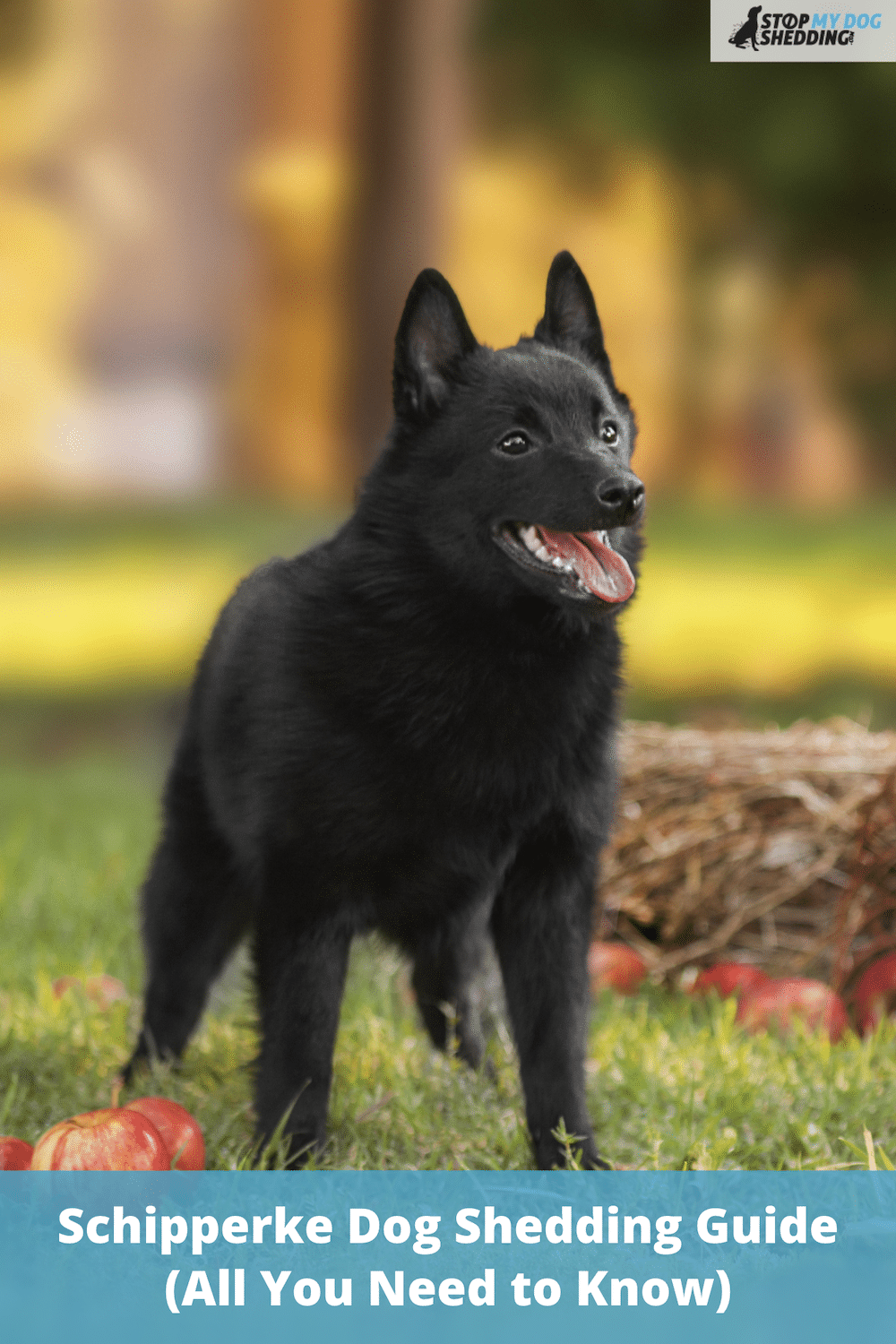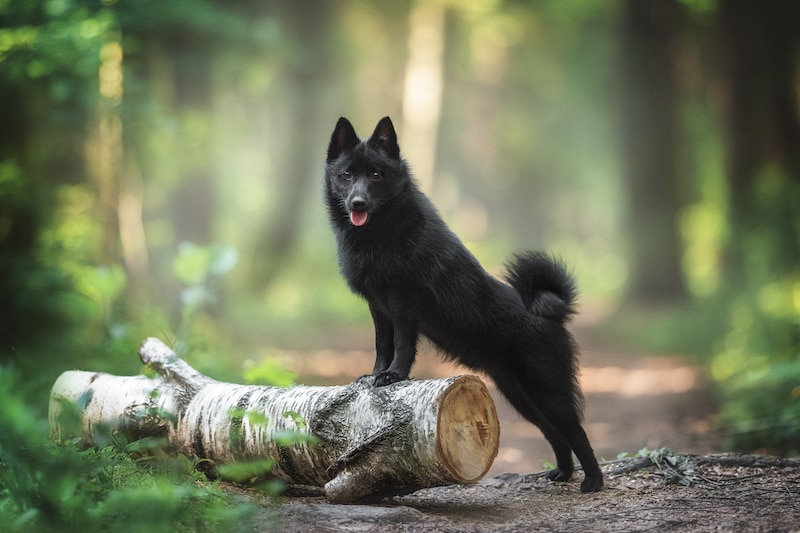The Schipperke is a tiny dog from Belgium that’s beloved for its dark coat. If you’re interested in bringing home this sweet, curious, confident dog, you may have questions about how much the breed sheds.
So, do Schipperkes shed a lot? Despite their size, Schipperkes do shed quite a lot during seasonal shifts. However, for the rest of the year, they only shed moderately. And grooming this breed is relatively easy, so you’ll have plenty of time for fur cleanup.
This article will dive deeper into the shedding habits of Schipperkes, including the times of the year this dog sheds more versus less. I’ll also discuss grooming requirements and whether this small Belgian dog is considered hypoallergenic.
Recommended: Go here to see our top-rated dog hair blow dryers
Schipperke Shedding
The thing about small dogs is they can deceive you into thinking they’re low-shedding solely due to their size. In the case of the Schipperke, though, looks can be deceiving.
The Schipperke sheds moderately to heavily depending on the season.
To understand why let’s take a closer look at the Schipperke’s coat.
This small dog has a double coat. The undercoat, or bottommost layer, is for insulating the dog. The outer coat is more for waterproofing and dirt-proofing, at least to an extent. This coat has a rough texture.
Double-coated dogs are almost always prone to seasonal shifts that alter how much the breed sheds. This is true of the Schipperke as well.
As you begin digging out your winter sweaters, this is the first period of the year when your dog will begin shedding furiously. In removing their lighter coat, the Schipperke can grow a thicker undercoat that’s better for insulation.
Then, just as you’re getting ready to bid winter adieu, your Schipperke will begin shedding to the same extent again. This time, they’re dropping their winter coat for a lighter-weight summer coat.
The Schipperke will shed consistently for the rest of the year, but it won’t seem like nearly as much loose fur as the seasonal shedding spikes.
And one of the primary reasons the Schipperke is a moderate shedder outside of these times is that its fur is longer. All dogs go through a hair growth cycle that includes four stages. Longer fur tends to progress through those growth stages more slowly than short fur, reducing the hair cell turnover speed and the amount of shedding.
Grooming Your Schipperke
Keeping the Schipperke well-groomed is much less of a headache than vacuuming up its small piles of black hair in the winter or summer. That said, grooming is not altogether without its challenges.
The Schipperke does not have a uniform coat length throughout. The breed features a longer area of fur around the neck that’s known as a ruff. Down the dog’s back and to its tail is another strip of hair that’s longer than usual.
The hocks, fronts of its forelegs, ears, and face should have shorter fur. The body should feature mid-length fur, and the culottes, jabot, and cape–in addition to the ruff–should be left to grow longer.
A culotte is the same length as the ruff. The jabot starts at the chest and then goes down between the dog’s two front legs. The cape is the fur past the ruff.
Let’s start with brushing. If the dog isn’t going through one of its seasonal shedding episodes, then you can get away with brushing the Schipperke once or twice per week.
I would recommend increasing the rate of brushing to every day when the Schipperke blows its coat. Use a pin brush for the job.
You shouldn’t have to trim the dog’s coat despite the varying hair lengths. Maybe you can take your Schipperke to the groomer’s if he’s getting a little long and scraggly, but this shouldn’t occur often.
Bathing your Schipperke is something you’ll have to do much more frequently, at least once per month.
The main reason to prioritize bathing your Schipperke is that a dirty coat can affect the hair shaft’s health. The hair shaft can become damaged if it’s dirty for too long.
And this can increase the chance of your dog getting cobweb matting (AKA spiderweb matting), a type of mat that usually begins very near the skin and spreads throughout the coat, causing the hair to become a solid sheet over the dog rather than individual clumps of hair.
This can be more painful than regular matting since the hair tangles nearer the Schipperke’s skin. And if it’s left unattended for too long, your dog could develop skin issues that could potentially increase the breed’s rate of shedding.
To bathe your Schipperke, fill a shallow basin with water, such as a kitchen sink. Moisten the dog’s coat with water and squeeze a dog-friendly shampoo over your Schipperke’s fur. It’s important to get through both layers of the dog’s coat and down to their skin when shampooing.
Since rinsing takes a while, I recommend using lukewarm to cool water, never warm or hot water. Keep rinsing until you see no more shampoo residue.
You can condition the Schipperke’s coat using a dog-friendly conditioner. And be sure to get it through all the hair strands for the best results.
When your dog hops out of the tub, gently blot its fur with a towel. Do not squeeze or rough up the fur to dry it, as you could cause tangles and mats. Or, if you own a dog hair blower, that can work even better for drying the Schipperke.
Then, brush your dog’s fur section by section to ensure there are no knots once the coat is dry, and finish with a slicker brush combing.
Are Schipperkes Hypoallergenic?
One of the reasons you might feel drawn to the Schipperke is if you heard this dog is hypoallergenic through the grapevine. Is it true?
I hate to be the bearer of bad news, but no dog is hypoallergenic.
There’s a reason for that too. If you’re allergic to dogs, that doesn’t mean their fur leaves you with hives. It’s their dander that does it.
Dander is merely dead skin that can float on fur. Dogs without fur or those that shed very little are the most hypoallergenic. However, since the dog has skin, it’s not 100 percent hypoallergenic.
So where does that leave the Schipperke? Ah, that’s a good question.
Usually, the size of a breed dictates how hypoallergenic it is. Since the Schipperke is small, this is an open-and-shut case, right?
Not exactly. Small dogs typically aren’t heavy shedders, but there are exceptions to every rule. In this case, the Schipperke is one such exception.
Since this dog sheds during seasonal changes, that’s several weeks twice per year when its dead skin can float on the departing fur and travel throughout the house. If you’re an allergy sufferer, your rate of symptoms will coincide with your Schipperke’s seasonal shedding.
While controlling a dog’s diet, exercise, and grooming can reduce shedding; you can’t stop seasonal fur blow. Thus, if you or someone in your family has dander allergies, I would not recommend the Schipperke.
Is a Schipperke Right for You?
Perhaps you and your family don’t have allergies. In that case, then you might still be strongly contemplating adopting a Schipperke. Is this the right decision? Let’s explore.
The Schipperke is a small dog from Belgium. Its origins are heavily debated. In Belgium, the Schipperke is regarded as a Shepherd (albeit a small one), whereas others argue the breed is a Miniature Sheepdog or a Spitz.
First bred in the 1880s, the Schipperke had a major role in World War II. Belgian troops relied on the dog to send messages to cells and hideouts by foot. The dog also acted as an excellent hunter.
The American Kennel Club describes the Schipperke’s temperament as curious, alert, confident, and stealthy.
With its small size of 12 to 13 inches tall in maturity, the Schipperke won’t feel too constricted in an apartment or small house.
That said, make sure you spend plenty of time playing with your Schipperke, as this is one active dog. If your home doesn’t have a large yard, then head to the closest park.
Outside of its need for physical activity, the Schipperke also requires mental stimulation. The same old game of fetch or tug-of-war won’t suffice for this smart canine. You’ll need to keep him busy.
Do you have other dogs in the house? With a bit of time and socialization, the Schipperke can learn to love them.
Despite being a hunting dog, the Schipperke is a friend of cats, too. Perhaps because both animals have such razor-sharp reflexes.
The Schipperke loves children, but I’d still suggest you spend adequate time helping your dog get to know its new human family members.
Are you concerned about barking? That’s fair. After all, the Schipperke can bark to excess, as they are watchdogs. Even when not guarding your home, this breed tends to be very vocal. In that case, you might want to consider behavioral training to reduce unwanted barking.
Bottom Line
The Schipperke is a small dog from Belgium originally bred for keeping watch and hunting. This dog sheds like a dickens when the seasons change. During other times of the year, the shedding isn’t so bad.
Grooming your Schipperke isn’t difficult, per se, but it does take a lot of consideration to avoid knotting the dog’s sensitive fur.
If you’ve been thinking of adopting a Schipperke, I hope the information in this guide helps you make up your mind!













Please note: By submitting a comment using the above comment form, you confirm that you agree with the storage and handling of your data by this site as detailed in our Privacy Policy.